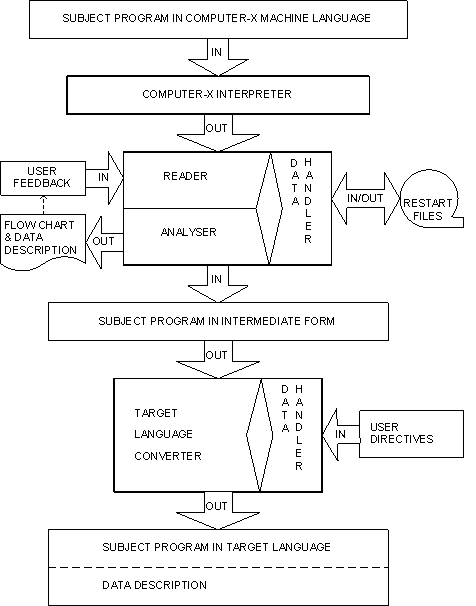The PILER Decompilation System
- Interpretation of the subject (input) program's "commands" (the Interpreter)
- Analysis of the source program for function and data usage (the Analyser)
- Expression of the source program in the target language (the Converter)
 A reproduction of Figure 2 of [Barb74], complete with upper case text.
A reproduction of Figure 2 of [Barb74], complete with upper case text.
The "interpreter" phase
The "interpreter" phase (not a program interpreter as we would use the term now) ran on the source machine, and has the input program loaded with it (just insert the cards into the deck!). The interpreter therefore used the loader and operating system of the source machine. The output of this phase (the first intermediate representation) was called Micro Form. This was supposed to be general, but reflected the narrow variety of machines at that time. Instead of making this a clean interface, they decided that Micro Form could be in any form that was convenient for the interpreter phase, as long as the subroutine RMR (Read Microform Record) in the Analyser phase could read it. The interpreter phase had three subphases: loader, analysis (not the same as the analysis phase; this subphase just attempts to separate code from data), and interpretation. The analysis subphase generated several data structures: a memory map, symbol table, subroutine table, data reference table, and an input/output buffer table. It seems that the opcode field was often used to decide if a word was instruction, data, or I/O control. "Secondary microforms" were appended for indexed instructions and the like.Micro Form
Microform was the low level intermediate representation. It was 3 address.The analyser phase
This phase could be run on any computer, not necessarily the source or target machines. The basic procedures were (from [Barb74]):- First level analysis. Memory mapping for separation of program instructions and data. Division of program into logical blocks. Preliminary "timing analysis". Flagging of indexed or modified branch addresses and operation codes. Subroutine analysis.
- Data analysis. Historical use of data locations and registers. Formats of data.
- Second level analysis. Analysis of modified addresses and operation codes and completion of first level analysis and data analysis for any additional segments. Program reduction.
- "Timing analysis". Assignments of computational priorities based on data usage requirements.
- Third level analysis. Reduction of program to functional level, rather than instructive level.
- Preparation of flowchart blocks.
- Preparation of Intermediate Form subject program.
- Reader (contains the Read Microform Record (RMR) subroutine)
- Data handler
- Analyser
- Flow charter
- Program modifier (accepts directives from the user to modify the subject program).
Intermediate Form
Intermediate Form is the high level intermediate representation. It was designed with the following languages as likely targets: FORTRAN, COBOL, ALGOL, JOVIAL, and PL/1. To give a flavour, here are some of the codes: Mathematical Symbols001 Plus 010 Reciprocal 002 Minus 011 Exponent 003 Unary minus 012 Boolean OR 004 Inverse subtract 013 AND 005 Multiply 014 EXTRACT 006 Divide 015 EXCLUSIVE OR 007 Inverse divide 016 EQUIVALENT 020 Equals 017 CONDITIONALInternal Functions
140 I/O Subfields
01 Test 10 Input
02 Position 20 Close
04 Output 40 Open
040 Round 050 Modulo
041 Normalise 051 Remainder
042 Adjoin 052 Absolute value
043 Largest integer 053 Set ON (-,1)
044 Smallest integer 054 Set OFF (+,0)
045 Maximum
046 Minimum
100 Test
101 Compare Subfield
102 Search 01 Match
103 Sort 02 Mismatch
104 Enter 03 Max value in array
105 Move 04 Min value in array
05 Greater than comparand
06 Greater or equal to comparand
07 Less or equal to comparand
10 Between limits of 2 comparands
11 Next lower than comparand
12 Next higher than comparand
120 Internal procedure
130 External procedure
Operand types:
01 Constant 02 Literal 04 Variable 05 Subscripted variable 06 Subscript 10 Function 11-16 Parameters as 01-06 above 20 I/O list 30 Format list
The Converter phase
This phase wrote the high level language. Apparently there were so many dialects of COBOL in those days, that they suggested that the Converter should handle all the variations. They wrote "skeletal converters" for FORTRAN and COBOL (they claim that most of their effort was spent on the analysis phase).Conclusion
ALthough this appears to have been a genuine attempt at a flexible, general system, it seems to have assumed many characteristics of machines common in its day, but not common now. It is a real shame that it was never properly finished (as far as I can tell), e.g. that more interpreter phases were never written. -- MikeVanEmmerik - 07 Jul 2003Revision: r1.2 - 07 Jul 2003 - 08:00 - MikeVanEmmerik